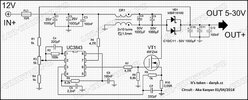Hello friends
I assembled this circuit
When I measure the output with a voltmeter everything is fine.
But when something like a battery or a lamp or a DC motor is connected to the output, the output of the circuit becomes close to zero
I have been dealing with this problem for a long time and I have discussed it with different people, but I still haven't reached the result
please guide me
I assembled this circuit
When I measure the output with a voltmeter everything is fine.
But when something like a battery or a lamp or a DC motor is connected to the output, the output of the circuit becomes close to zero
I have been dealing with this problem for a long time and I have discussed it with different people, but I still haven't reached the result
please guide me


